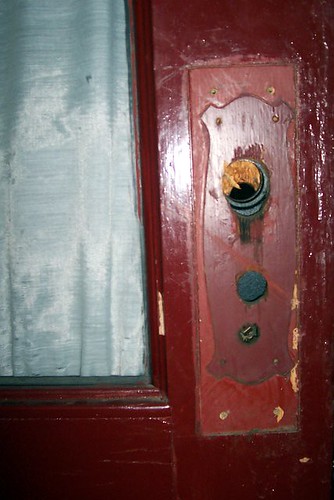 We've been having a bit of trouble lately with the back door knob not catching the latch. You could stand there spinning the knob several times before it actually opened the door. So I thought, why not pop off the lock and see what's going on in there.
We've been having a bit of trouble lately with the back door knob not catching the latch. You could stand there spinning the knob several times before it actually opened the door. So I thought, why not pop off the lock and see what's going on in there.When I had spoke to Robert a couple years ago, he lamented the fact that his sister had replaced the original exterior door locks with modern ones. He thought she was just a nervous New Yorker (with apologies to all my friends out East) who didn't trust anybody and that there was no reason to do away with perfectly good skeleton key locks. At least the style she picked goes nicely with the decor.
 There are some unique features to these locks, one is pictured to the left. Under the latch are two push buttons. Push one in and both knobs work, push in the other and only the inside knob turns making it impossible to open the door from the outside. Now I think I understand why someone would want this type of lock, but with curious little kids' fingers we've had a couple close calls on being locked out of the house.
There are some unique features to these locks, one is pictured to the left. Under the latch are two push buttons. Push one in and both knobs work, push in the other and only the inside knob turns making it impossible to open the door from the outside. Now I think I understand why someone would want this type of lock, but with curious little kids' fingers we've had a couple close calls on being locked out of the house. What makes it work is a split shaft that connects the knobs. It's actually jointed in the middle, sort of like dual suspension on a car. What had caused the knob to slip was a general loosening of the mechanism, shifting the joint off center. A couple set screw adjustments and it works great.
Another interesting find was the color progression for the exterior that can be  seen underneath each of the outlines for the plates. The original scalloped plate is identical to all the interior door handles. I don't know what happened to them but it's obvious that the door had to be drilled out more to accommodate the new lock mechanism. I'm also surprised that the plates weren't painted over, but they obviously didn't bother to remove them either.
seen underneath each of the outlines for the plates. The original scalloped plate is identical to all the interior door handles. I don't know what happened to them but it's obvious that the door had to be drilled out more to accommodate the new lock mechanism. I'm also surprised that the plates weren't painted over, but they obviously didn't bother to remove them either.
 seen underneath each of the outlines for the plates. The original scalloped plate is identical to all the interior door handles. I don't know what happened to them but it's obvious that the door had to be drilled out more to accommodate the new lock mechanism. I'm also surprised that the plates weren't painted over, but they obviously didn't bother to remove them either.
seen underneath each of the outlines for the plates. The original scalloped plate is identical to all the interior door handles. I don't know what happened to them but it's obvious that the door had to be drilled out more to accommodate the new lock mechanism. I'm also surprised that the plates weren't painted over, but they obviously didn't bother to remove them either.
We have this same lock mechanism on our (now interior) front door, and you can remove the pushbuttons to disable the "function" that is, as you have noted, so attractive to little fingers. Ours came that way, but it's fairly simple to do.
ReplyDelete